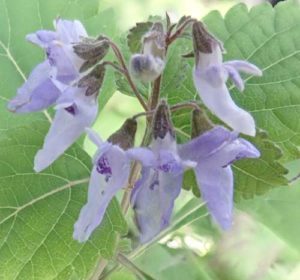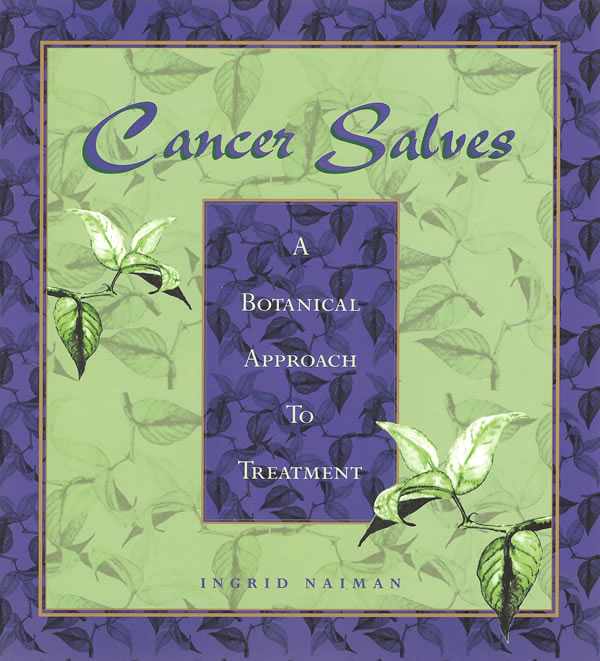Mission Statement
by Ingrid Naiman
When I began researching escharotic treatments of cancer, I realized that desperation for hugely effective medicinal plants had nearly caused the extinction of certain plants, this as far back as the early 1700s when Native American herbs were articles of trade, often being exchanged for slaves and other “articles” of commerce.
If my book on botanical cancer treatments were to become successful, demand for plant material would exceed supply, especially where goldenseal and bloodroot are concerned since these two plants are endangered. I am a writer and healer, not a botanist much less a conservationist. In my work, patients respond to my “excuses” about lack of availability of plant material with “what about me?” This is an absolutely appropriate question, but many years ago, I vowed I would not go any further with the production of cancer salves until at least 2000 acres were put under cultivation with the plants needed in the formulas.
 The use of external pastes, plasters, and salves for cancer is ancient and efficacious. The preparations described in my book are based on Native American herbs that were adapted by European settlers, lay and professional practitioners, in such a way as to form a bridge between natural and allopathic medicine. These treatments therefore hold a special place in medical history as one of the few methods of cancer management that combines ethnobotanical traditions with modern medicine, herbal with chemical substances, and lay with “official” medicine — and, I suspect the reason for this is that the treatments have stood the test of time.
The use of external pastes, plasters, and salves for cancer is ancient and efficacious. The preparations described in my book are based on Native American herbs that were adapted by European settlers, lay and professional practitioners, in such a way as to form a bridge between natural and allopathic medicine. These treatments therefore hold a special place in medical history as one of the few methods of cancer management that combines ethnobotanical traditions with modern medicine, herbal with chemical substances, and lay with “official” medicine — and, I suspect the reason for this is that the treatments have stood the test of time.
When I have explained the supply issues to farmers, investors, as well as doctors wishing to perform clinical trials, I have often found that people appreciate the problems I have described and that they sincerely wish to contribute to the continued availability of plant medicines.
In starting this site, I fully recognize that more understanding of the plants is likely to endanger them further so it is my goal to provide as much information on the natural habitat and growing conditions required by plants as needed to encourage individuals and perhaps also philanthropists and conservationists to cultivate plants, both by propagating the needed plants and by developing new farms that contribute to bio-diversity and sustainability.
We live in unbelievably perilous times. We are threatened by herbicides and pesticides and acidic water; chemtrails and contrails; and genetically modified crops that are “infecting” native species, even in remote areas of the Planet. The air is polluted by fossil fuels and other emissions; the ozone layer has holes in it. We and the plants are being irradiated; and, as if this were not enough, leaders are beating war drums and tossing around words like “nuclear” and “biochemical” as though these weapons pose short-term problems for target populations rather than long-term challenges for our entire Plant and its precious ecosystem.
For most of my life, I tried to contain differences. Being a philosopher by nature, the issues that divide tended to fascinate me. I felt that if sincere people sought truth, they would find it; and the truth itself would eradicate the miasms. In a sense, I figured we would all be seeing with the mystical eye, polarities would cease to divide, divisiveness and the tensions they engender would end, and we would all live happily ever after. Frankly, I still believe this, but maybe we need to have a calendar.
Lately, I gave up diplomacy and the fine art of “bridging.” I realize that if we want to have a future, we have to make adequate preparations by preparing the alternative to the present. This means sustainable agriculture, one that supports health for our entire ecosystem, not just for humans but for plants and animals. Trees need clean water and wholesome air as much as animate creatures.
This site is therefore offered as a place to network. If you have land on which you would like to grow herbs, you can study the material here, visit the linked sites, read books and web material, and determine not only what will grow best, but what is most needed. If you want to adopt land so as to conserve or preserve it, you may also want to know if there are valuable medicinal plants on the land. If you make plant medicines, you can let others know which plants you need. Though patients may find information that helps them in their treatment decisions, this is not the purpose of this site. The intention is to promote continuity of availability of plants used in making medicine—and to support all local and indigenous medicinal herb traditions by providing respect for their knowledge and outlets for their crops.
It is my firm belief that all “perfect” situations are win-win. A healthy environment supports health for those who live in that environment. Cleaner water is good for everyone as is cleaner air. Organic or biodynamically grown foods and herbs are healthier than those laced with chemical residues and corrupted by engineering experiments. Natural medicine is both gentler and healthier than medicine made of poisons and chemicals. People who rely on such foods and medicines are less toxic and therefore less aggressive. As we learn to treasure our plants, they respond by giving back more energy. When we value our medicine, we are willing to pay the farmers who cultivate the crops what they need in order to live comfortably. The world becomes a saner and safer place.
 It is the Nature of plants to perform service. Photosynthesis puts wholesome oxygen into the air. Plants provide nourishment and medicine, feasts for the eyes and soul, scents for the body and spirit, and inspiration for those who have lost the guiding impulse of Light. We owe the Plant Kingdom a great deal for all it offers us. My mission is to promote a higher level of concern for the trusteeship of our most valuable medicines.
It is the Nature of plants to perform service. Photosynthesis puts wholesome oxygen into the air. Plants provide nourishment and medicine, feasts for the eyes and soul, scents for the body and spirit, and inspiration for those who have lost the guiding impulse of Light. We owe the Plant Kingdom a great deal for all it offers us. My mission is to promote a higher level of concern for the trusteeship of our most valuable medicines.Many experts throughout history have regarded cancer salves and pastes as the most thorough, safe, and efficacious way to treat cancer, especially skin and breast cancers but also cancers of other organs. In this book, Ingrid Naiman meticulously traces the use of such products in ancient India and by Hildegard of Bingen, Native Americans, and modern physicians. She provides detailed instructions for making and using the salves, a fair comparison of the pros and cons, and eight pages of color pictures showing responses to the products. Visit her Cancer Salves site for more information, answers to frequently asked questions, and a checklist for people facing cancer.

Cancer Plants
Donations
Your donations are greatly appreciated.
Information
Newsletter
To be notified of new posts to this site, please subscribe, using the link button below. You can cancel your subscription at any time you choose.
Copyright by Dr. Ingrid Naiman 2003 and 2018
All Rights Reserved || Institute for Invisible Epidemics
